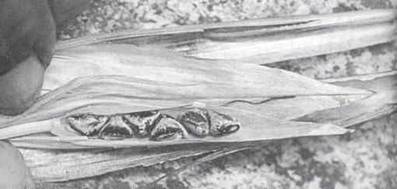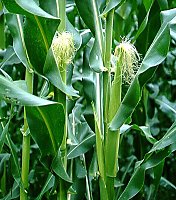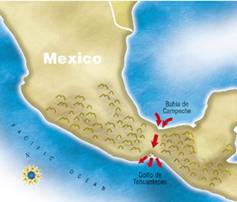


Origins |
|||||||||||||||||||||||||
 |
| Teosinte |
There is solid evidence that maize was domesticated from teosinte at least 6300 years ago in Mexico. More recent archaeological findings that suggest that domestication could have begun as early as 9,000 years ago! According to the November 2003 article Prehistoric GM Corn (Science Magazine), "Maize most probably arose from teosinte of the subspecies parviglumis in the Balsas River basin of southern Mexico roughly 9,000 years ago." Cobs found in a cave in that area were recently re-dated and demonstrated to be more than 6200 years old.
While we cannot be certain that corn originated in Mexico, evidence certainly points in that direction. 80,000 year-old corn pollen grains have been obtained from drill cores below Mexico City. And, an archaeological study of bat caves in New Mexico, 5,600 year-old corn cobs.
Beyond the archaeological evidence, there is physical evidence that points to Mexico as the originating site of corn. It is only in Mexico that we can still find plants which can be cross-bred and cultivated to produce maize.
|
Isthmus of Tehuantepec |
Maize most likely originated north of the Isthmus of Tehuantepec located in the southern part of the Mexican states of Oaxaca and Vera Cruz.
The Isthmus of Tehuantepec is located near the ancient seat of the Maya and thus, it is not surprising that there are many Native American traditions and legends that point to the far southwest as the mother country of the corn plant. One Mesoamerican myth of maize that is quite common. A fox follows an ant and discovers a stash of maize enclosed within a large mountain or boulder. The fox eats the grain and later on in his flatulence, realizes that he has found a wondrous new food. Another Mesoamerican myth speaks of maize as being created in four successive steps, each step improving the grain until the last step, which brought forth the best possible food-maize in its present form.
There are many other maize/creation stories from other Aboriginal peoples all over the Americas. Many speak about the origins of life being connected to the origins of maize. They all speak of a deep reverence for maize as the source of life
From the 1940s to the 1960s, researchers excavated a number of arid caves located on highland areas in Central Mexican plateaus. Teams of scientists, led by archaeologists, used dating methods to come up with the approximate ages of artifacts found in the caves. They found evidence that showed the following
| 4,000 to 3,000 B.C. |
There was a shift from hunter-gatherer lifestyles to early farming in the present-day Mexican states of Tamaulipas, Puebla, and Oaxaca. It is likely that small bands of people followed the seasonal patterns of plants and animals in order to live. During this period, they experimented with parched grains and cereal meal. |
| 2,700 B.C. |
Maize was introduced and the people living in the Coxcatlan caves were using a small-eared pop maize with 6 to 9 kernels per cob. They were grinding maize grain with stone mortars and baking flat bread from the meal. |
| 1,400 B.C. |
Maize cultivation reached both Mexican coasts and spread to peoples in the central highlands, southern gulf coast and Chiapas/Guatemala lowlands. |
| 500 to 1100 A.D. |
Princess Point people, who existed in the Grand River area of Ontario (lower Great Lakes region) were the first to conduct the large-scale planting of corn. Dating techniques show that the shift to corn as a major part of the diet began about 800 A.D. and progressed rapidly between 900 and 1000 A.D. |
| 1492 A.D. |
When Christopher Columbus came to America in 1492, he observed maize growing on the island of Haiti and his writing of this becomes the first known written record of that plant. Native Americans who domesticated corn developed five different types of corn: pop, flint, dent, flour, and sweet corn. These differ in the hardness of the seed coat and in the kind and amount of starch or sugar stored in each kernel. |
| 1534 A.D. |
Explorer Jacques Cartier noted the existence of cornfields along the north shore of the St. Lawrence River in Iroquois settlements. |



